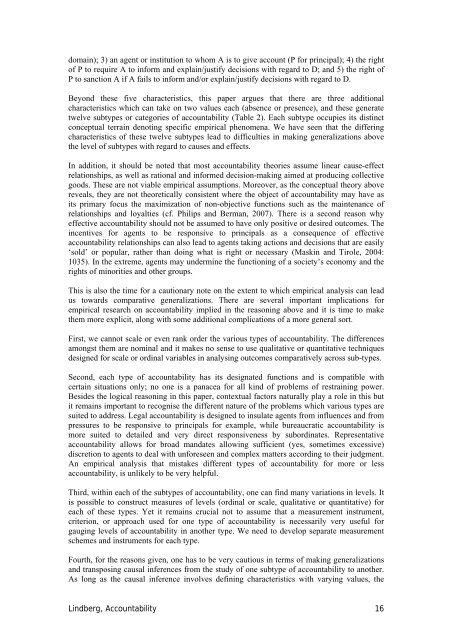Accountability
Accountability
Accountability
Create successful ePaper yourself
Turn your PDF publications into a flip-book with our unique Google optimized e-Paper software.
domain); 3) an agent or institution to whom A is to give account (P for principal); 4) the right<br />
of P to require A to inform and explain/justify decisions with regard to D; and 5) the right of<br />
P to sanction A if A fails to inform and/or explain/justify decisions with regard to D.<br />
Beyond these five characteristics, this paper argues that there are three additional<br />
characteristics which can take on two values each (absence or presence), and these generate<br />
twelve subtypes or categories of accountability (Table 2). Each subtype occupies its distinct<br />
conceptual terrain denoting specific empirical phenomena. We have seen that the differing<br />
characteristics of these twelve subtypes lead to difficulties in making generalizations above<br />
the level of subtypes with regard to causes and effects.<br />
In addition, it should be noted that most accountability theories assume linear cause-effect<br />
relationships, as well as rational and informed decision-making aimed at producing collective<br />
goods. These are not viable empirical assumptions. Moreover, as the conceptual theory above<br />
reveals, they are not theoretically consistent where the object of accountability may have as<br />
its primary focus the maximization of non-objective functions such as the maintenance of<br />
relationships and loyalties (cf. Philips and Berman, 2007). There is a second reason why<br />
effective accountability should not be assumed to have only positive or desired outcomes. The<br />
incentives for agents to be responsive to principals as a consequence of effective<br />
accountability relationships can also lead to agents taking actions and decisions that are easily<br />
‘sold’ or popular, rather than doing what is right or necessary (Maskin and Tirole, 2004:<br />
1035). In the extreme, agents may undermine the functioning of a society’s economy and the<br />
rights of minorities and other groups.<br />
This is also the time for a cautionary note on the extent to which empirical analysis can lead<br />
us towards comparative generalizations. There are several important implications for<br />
empirical research on accountability implied in the reasoning above and it is time to make<br />
them more explicit, along with some additional complications of a more general sort.<br />
First, we cannot scale or even rank order the various types of accountability. The differences<br />
amongst them are nominal and it makes no sense to use qualitative or quantitative techniques<br />
designed for scale or ordinal variables in analysing outcomes comparatively across sub-types.<br />
Second, each type of accountability has its designated functions and is compatible with<br />
certain situations only; no one is a panacea for all kind of problems of restraining power.<br />
Besides the logical reasoning in this paper, contextual factors naturally play a role in this but<br />
it remains important to recognise the different nature of the problems which various types are<br />
suited to address. Legal accountability is designed to insulate agents from influences and from<br />
pressures to be responsive to principals for example, while bureaucratic accountability is<br />
more suited to detailed and very direct responsiveness by subordinates. Representative<br />
accountability allows for broad mandates allowing sufficient (yes, sometimes excessive)<br />
discretion to agents to deal with unforeseen and complex matters according to their judgment.<br />
An empirical analysis that mistakes different types of accountability for more or less<br />
accountability, is unlikely to be very helpful.<br />
Third, within each of the subtypes of accountability, one can find many variations in levels. It<br />
is possible to construct measures of levels (ordinal or scale, qualitative or quantitative) for<br />
each of these types. Yet it remains crucial not to assume that a measurement instrument,<br />
criterion, or approach used for one type of accountability is necessarily very useful for<br />
gauging levels of accountability in another type. We need to develop separate measurement<br />
schemes and instruments for each type.<br />
Fourth, for the reasons given, one has to be very cautious in terms of making generalizations<br />
and transposing causal inferences from the study of one subtype of accountability to another.<br />
As long as the causal inference involves defining characteristics with varying values, the<br />
Lindberg, <strong>Accountability</strong> 16

















